SS Canberra
SS Canberra was an ocean liner, which later operated on cruises, in the P&O fleet from 1961 to 1997. She was built at the Harland and Wolff shipyard in Belfast, Northern Ireland at a cost of £17,000,000. The ship was named on 17 March 1958, after the federal capital of Australia, Canberra. She was launched on 16 March 1960, sponsored by Dame Pattie Menzies, GBE, wife of the then Prime Minister of Australia, Robert Menzies. She entered service in May 1961, and made her maiden voyage starting in June. She appeared in the 1971 James Bond film Diamonds Are Forever. In the 1982 Falklands War she served as a troop ship. In 1997 the singer and songwriter Gerard Kenny released the single "Farewell Canberra" which was specially composed for the last voyage.
 SS Canberra in Sydney 1974. | |
| History | |
|---|---|
| Name: | Canberra |
| Namesake: | City of Canberra, Australia |
| Owner: |
1961-1988, |
| Operator: |
|
| Port of registry: |
|
| Route: | Southampton-Sydney via Suez, thence Sydney-Vancouver (1973, Cruising) |
| Ordered: | 20 December 1956 |
| Builder: | Harland and Wolff, Belfast |
| Cost: | £17 million |
| Yard number: | 1621 |
| Laid down: | 23 September 1957 |
| Launched: | 16 March 1960 |
| Sponsored by: | Dame Pattie Menzies, GBE |
| Completed: | May 1961 |
| Maiden voyage: | 2 June 1961 |
| Out of service: | 10–31 October 1997 (final voyage) |
| Identification: |
|
| Nickname(s): | The Great White Whale |
| Honours and awards: | Falklands War |
| Fate: | Scrapped at Gadani ship-breaking yard, Pakistan, 1997-1998 |
| General characteristics | |
| Tonnage: |
|
| Length: | 820 feet (250 m) |
| Beam: | 103 feet (31 m) |
| Draught: | 35.5 feet (10.8 m) |
| Propulsion: |
|
| Speed: |
|
| Capacity: | 150,000 cubic feet (4,200 m3) of cargo |
| Complement: | 1961–73: 548 First class, 1,690 Tourist class, 1973–97: 1,737 one class |
| Crew: | 1961-73, 900. 1973-97, 795 |
History
Ocean liner
P&O commissioned Canberra to operate the combined P&O-Orient Line service between the United Kingdom and Australasia and designed her to carry 548 first class passengers and 1,650 tourist class. Too big for Tilbury she was based at Southampton. Her first voyage set out on 2 June 1961 through the Suez Canal and called at Colombo, Fremantle, Melbourne, Sydney, Auckland, Suva, Honolulu, San Francisco and Los Angeles returning to Southampton by the same ports. By the middle of 1963 she had spent many months in Drydock in Southampton and in the builder's yard for repairs to her electrical and mechanical systems.[1]
The era of mass air travel had begun by the time the Canberra was laid down and air travel prices fell relentlessly in the early 1960s to challenge P&O's lowest fares. In the second half of 1962 Canberra made a short cruise from Southampton followed by two more to New York. More cruises followed but nevertheless most of the ship's first decade was spent on the Australia run.[1]
Cruises
At the end of 1972 she was withdrawn and refitted to carry 1,500 single class passengers on cruises.[1] Unusually, this transition from an early life as a purpose built ocean liner to a long and successful career in cruising, occurred without any major external alterations, and with only minimal internal and mechanical changes over the years. One of her public rooms included a 'Cricketers Tavern', which contained a collection of bats and ties from cricket clubs all over the world; she also had the William Fawcett reading/writing room, named for the first P&O ship.[2]
Engineering
Like RMS Strathnaver and RMS Strathaird that she replaced on the Tilbury – Brisbane route, Canberra had turbo-electric transmission. Instead of being mechanically coupled to her propeller shafts, Canberra's steam turbines drove large electric alternators that provided current for electric motors that, in turn, drove the vessel's twin propellers. They were the most powerful steam turbo-electric units ever installed in a passenger ship; at 42,500 hp (31,700 kW) per shaft, they surpassed SS Normandie's 40,000 hp (30,000 kW) on each of her four shafts. This would give her a speed of about 27.25 knots (50.47 km/h). She also had a bow propeller for manoeuvring in port and docking manoeuvres. She was also the first British passenger liner to use alternating current as power.[3]
There are several operational and economical advantages to such electrical de-coupling of a ship's propulsion system, and it became a standard element of cruise ship design in the 1990s, over 30 years after Canberra entered service. However, diesel engine and gas turbine driven alternators are the primary power source for most modern electrically propelled ships.
Canberra had a bulbous bow, two sets of stabilizers, and two funnels side-by-side. The lifeboats, which were made from glass fibre, were placed three decks lower than usual for ships of her type, and were recessed into the hull to allow improved view from the passenger decks.
Falklands War

On 2 April 1982, Argentina invaded the Falkland Islands, which initiated the Falklands War. At the time, Canberra was cruising in the Mediterranean. The next day, her captain Dennis Scott-Masson received a message asking his time of arrival at Gibraltar, which was not on his itinerary. When he called at Gibraltar, he learnt that the Ministry of Defence had requisitioned Canberra for use as a troopship. Canberra sailed to Southampton, Hampshire where she was quickly refitted, sailing on 9 April for the South Atlantic.[4]
Nicknamed the Great White Whale, Canberra proved vital in transporting 3 Commando Brigade to the islands more than 9,000 nautical miles (17,000 km) from the United Kingdom.[4] Canberra was sent to the heart of the conflict.[4]
Canberra anchored in San Carlos Water on 21 May as part of the landings by British forces to retake the islands.[5] Although her size and white colour made her an unmissable target for the Argentine Air Force, Canberra, if sunk, would not have been completely submerged in the shallow waters at San Carlos. However, the liner was not badly hit in the landings as the Argentine pilots tended to attack the Royal Navy frigates and destroyers instead of the supply and troop ships. After the war, Argentine pilots claimed they were told not to hit Canberra, as they mistook her for a hospital ship.[6]
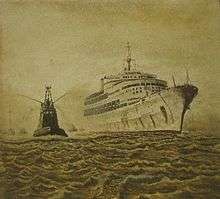
Canberra then sailed to South Georgia, where 3,000 troops were transferred from Queen Elizabeth 2. They were landed at San Carlos on 2 June. When the war ended, Canberra was used as a cartel to repatriate captured Argentine soldiers, landing them at Puerto Madryn, before returning to Southampton to a rapturous welcome on 11 July. Captain Scott-Masson, who had started his apprenticeship on the Shaw, Savill & Albion Line troopship Empire Deben in the late 1940s, was awarded a CBE and made an aide-de-camp to Her Majesty The Queen.[4]
Final years
After a lengthy refit, Canberra returned to civilian service as a cruise ship. Her role in the Falklands War made her very popular with the British public, and ticket sales after her return were elevated for many years as a result. Age and high running costs eventually caught up with her though, as she had much higher fuel consumption than most modern cruise ships. Although Premier Cruise Line had made a bid for the old ship, P&O had already decided that they did not want Canberra to operate under a different flag. A replacement for the Canberra, the 1988-built Star Princess was transferred to P&O Cruises and was renamed Arcadia.
Canberra was withdrawn from P&O service in September 1997 and sold to ship breakers for scrapping on 10 October 1997, leaving for Gadani ship-breaking yard, Pakistan on 31 October 1997. Her deep draft meant that she could not be beached as far as most ships, and due to her solid construction the scrapping process took nearly a year instead of the estimated three months, being totally scrapped by the end of 1998.
Gallery
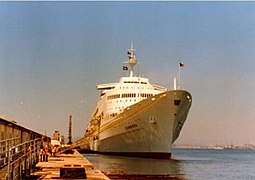 Canberra in Gibraltar August 1980 cruise 016
Canberra in Gibraltar August 1980 cruise 016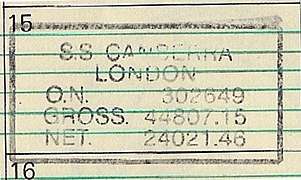 Canberra's official stamp
Canberra's official stamp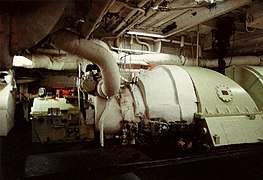 Canberra Port main steam turbine
Canberra Port main steam turbine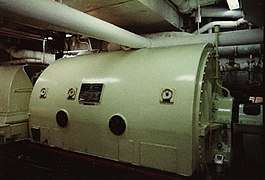 Canberra Port main propulsion alternator
Canberra Port main propulsion alternator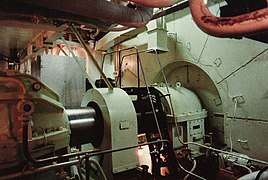 Canberra Port main propulsion motor
Canberra Port main propulsion motor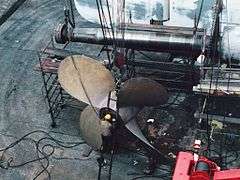 Canberra Starboard tail shaft and propeller
Canberra Starboard tail shaft and propeller
Media
SS Canberra is the liner where, in the James Bond film Diamonds Are Forever, Mr. Wint and Mr. Kidd try to kill Bond.[7]
The singer/songwriter Gerard Kenny released "Farewell Canberra" in 1997, which was written especially for the last voyage and a tribute to SS Canberra. The song mentions the ship giving a home and comfort to the Falklands soldiers who were "so brave and alone" and that for the many people who traveled on Canberra, she remains "always in our memory" and "our wonderful home on the sea."
Statistics
- Launched by Dame Pattie Menzies 16 March 1960
- Sailed from Belfast to Southampton 28 April 1961
- Entered P&O service 19 May 1961
- Fuel consumption; about 250 - 300 tonnes/day at sea
- Water consumption, engines; 200 tonnes/day
- Water consumption, domestic; 600 tonnes/day
- Water production capacity; 450 tonnes/day
- The top section of her radar mast was designed to cantilever astern to clear the Sydney Harbour Bridge
References
- Plowman, Peter. Australian Migrant Ships 1946-1977. Rosenberg, Australia. 2006. ISBN 1877058408
- "Ship Fact Sheet: William Fawcett (1828)" (PDF). P&O Heritage. November 2008. Retrieved 24 December 2019.
- http://www.gracesguide.co.uk/SS_Canberra
- "Captain 'DJ' Scott-Masson". London: Telegraph Group Newspapers. 1 December 2010. Retrieved 5 June 2011.
- https://www.theguardian.com/uk/2012/jun/15/captain-christopher-burne
- Ward, Sharkey (1992). "24". Sea Harrier over the Falklands. Cassell Military Paperbacks. p. 271. ISBN 0-304-35542-9.
- http://www.poheritage.com/the-collection/galleries/Posters/Cruising/CANBERRA---The-James-Bond-Ship
- Mitchell, WH; Sawyer, LA (1967). Cruising Ships. Doubleday.
Further reading
- Vine, Andrew (2012). A Very Strange Way to Go to War: The Canberra in the Falklands. Aurum Press. ISBN 978-1845137458.
- Correia, Luis Miguel; Miller, William H (1997). SS Canberra of 1961. Liner Books. ISBN 972-96940-5-2.
- Dawson, Philip (1990). British Superliners of the Sixties. Conway Maritime Press. ISBN 0-85177-542-X.
- Dawson, Philip. Canberra – In the Wake of Legend. Conway Maritime Press for P&O. ISBN 0-85177-707-4.
- McCart, Neil (1983). Canberra – The Great White Whale. Patrick Stephens Ltd. ISBN 0-85059-636-X.
- McCart, Neil (1989). P&O's Canberra – The Ship That Shaped The Future. Kingfisher Railway Publications. ISBN 0-946184-54-2.
- McCart, Neil (1993). P&O's Canberra & Sea Princess. Fan Publications. ISBN 0-9519538-2-6.
- McCart, Neil (1998). SS Canberra 1957–1997. Fan Publications. ISBN 1-901225-00-3.
- Muxworthy, Lt Cdr JL (1982). Canberra – The Great White Whale Goes To War. P&O.
- Odell, Carol (1968). A Liner Goes To Sea. Angus & Robertson. ISBN 2-07-949824-X.
External links
| Wikimedia Commons has media related to SS Canberra. |